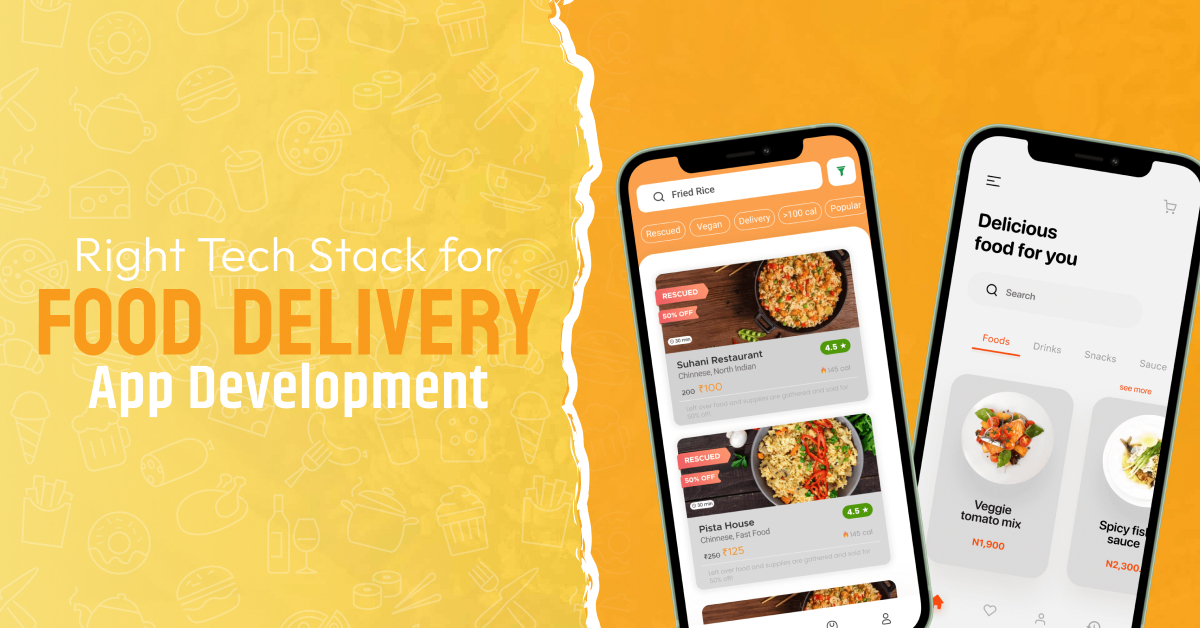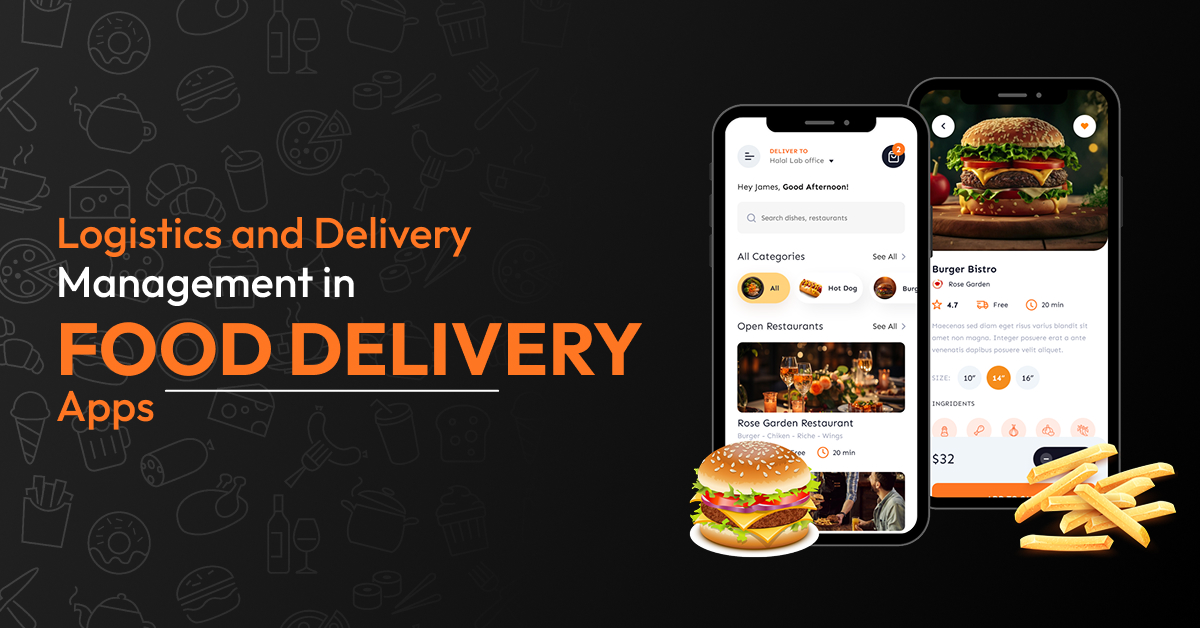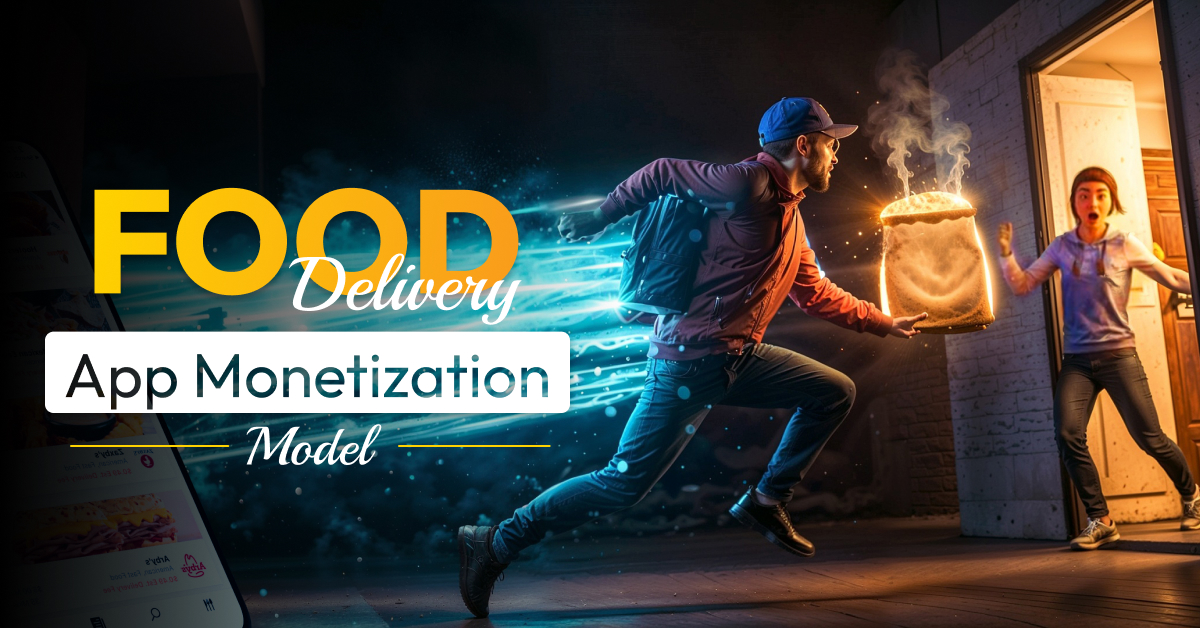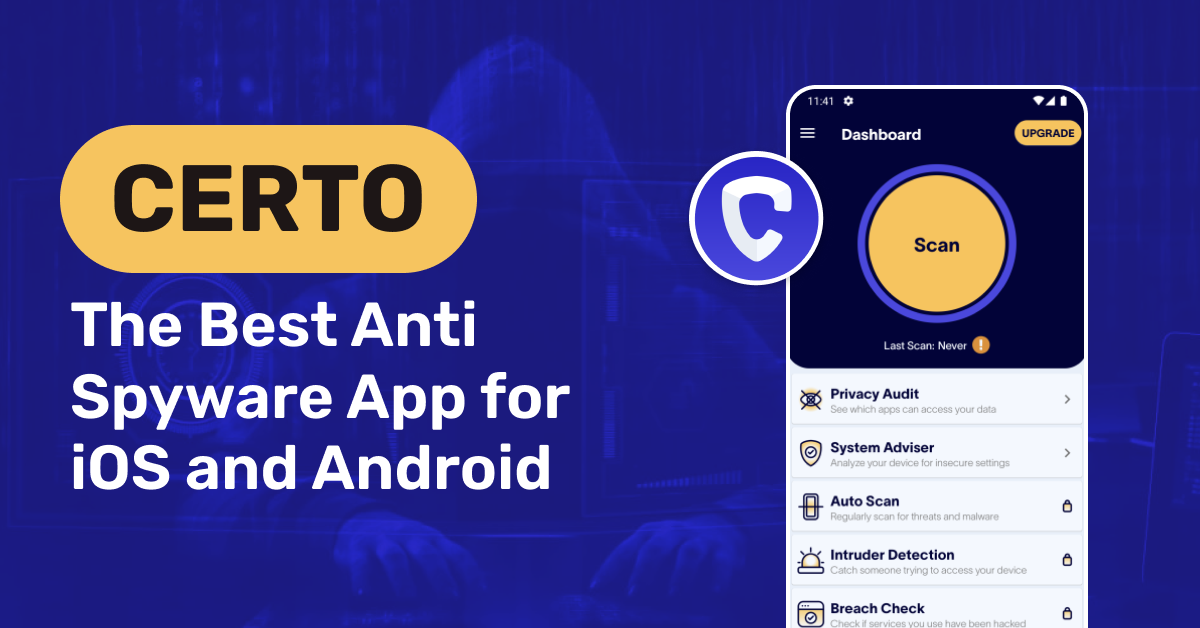Building a food delivery app that is scalable, safe, and high-performing requires careful consideration of the tech stack. Development speed, user experience, and maintenance are all directly impacted by the tech stack for food delivery app development. A contemporary meal delivery software usually incorporates a variety of full stack technologies, databases, APIs, native languages, and cross-platform frameworks.
Whether it’s safe payments, real-time tracking, or smooth user interaction, every element should be in line with the particular requirements of the app. By choosing tools that facilitate rapid deployment, the application can expand to meet user demands.
The best tech stack for delivery apps are discussed in this blog with detailed information. So, let’s get started and understand more.
Key Features of Food Delivery Apps
Apps for food delivery make it easier to order, track, and receive meals. These applications provide specialized panels for delivery workers, eateries, and administrators, guaranteeing end-to-end services:

1. Customer Panel
Users can place orders, browse menus, and securely pay via this panel. Consumers can view previous orders, assess their service, and track their delivery in real time. Promotions and push alerts improve user retention and engagement.
- User Registration
- Restaurant & Menu
- Order Placement
- Secure Payment Gateway
- Ratings & Order History
2. Delivery Panel
Delivery partners receive fresh order requests, use integrated GPS to navigate, and provide real-time delivery status updates. Tools for handling revenue, availability, and help inquiries are included in the food delivery app business model. It guarantees prompt delivery and easy client communication.
- Order Status Updates
- GPS Navigation
- Earnings & Delivery History
- Availability Toggle
- In-App Chat
3. Restaurant Panel
This dashboard is used by restaurants to manage availability, pricing, order status, and menu listings. They update meal preparation timetables, receive incoming orders, and monitor performance indicators. It enhances customer service and kitchen operations.
- Menu Management
- Order Notifications
- Status Management
- Business & Sales Reports
- Availability Settings
4. Admin Panel
All app operations, including those involving users, restaurants, orders, and transactions, are monitored by administrators. Use of food delivery app development services allow access to analytics and handle commissions. Strategic expansion and seamless platform operation are guaranteed by this panel.
- Portal Management
- Order Monitoring
- Commission & Payment
- Analytics & Reporting
- Promotions & Discounts
5. Advanced Features
The user experience is improved with chatbot assistance, voice ordering, multi-payment integration, loyalty programs, and AI-powered suggestions. Integration with IoT devices and smart wearables is becoming more prevalent. In a crowded market, these characteristics can set your software apart.
- AI-Based Food Recommendations
- Voice Search & Ordering
- Loyalty Programs
- Chatbots
- Multi-currency Support
Categorization of Tech Stack for Food Delivery App Development
A wide range tech stack for food delivery app development is needed. Real-time updates, secure data management, backend services, and front-end user interfaces are all supported by these technologies:
1. Frontend Technologies
i. React Native
Meta created the well-known open-source React Native framework for creating mobile applications with React and JavaScript. It is one of major Frontend technologies for delivery apps that lowers development expenses by enabling code sharing across iOS and Android.
ii. Flutter
A single Dart codebase can be used to create natively built apps with Google’s Flutter UI framework. It provides a hot-reload feature for quick development, expressive user interfaces, and quick rendering. Flutter is renowned for producing native-looking and -feeling, high-performance apps.
iii. Swift
Apple uses Swift, a contemporary programming language, to create iOS applications. It helps developers produce dependable code by offering safety, performance, and a clear syntax. Swift is closely linked with the frameworks and platforms of Apple.
iv. Kotlin
Google officially supports Kotlin, a statically typed programming language, for Android development. By providing complete Java interoperability, succinct syntax, and null safety, it enhances Java. Kotlin improves app security and productivity.
v. Vue.js
A progressive JavaScript framework for creating dynamic web interfaces is called Vue.js. It is appropriate for single-page apps, lightweight, and simple to incorporate. UI development is made easier by Vue’s component-based architecture and reactive data binding.
2. Backend Technologies
i. Node.js
A runtime environment called Node.js makes it possible to use JavaScript for server-side programming. It is the Backend for food delivery app that is quick and scalable. High-concurrency requirements are effectively handled by Node’s event-driven architecture and non-blocking I/O.
ii. Django (Python)
A high-level Python web framework called Django encourages quick development and simple, straightforward design. It has built-in functionality including an admin panel, ORM, and authentication. Django prioritizes scalability and security.
iii. Ruby on Rails
Ruby on Rails is a Ruby web framework that prioritizes convention over configuration. By automating repetitive operations, it streamlines food delivery app development solutions. Rapid prototyping and developer efficiency are hallmarks of Rails.
iv. Express.js
A simple and adaptable Node.js web application framework is called Express.js. It offers powerful functionality for creating web apps and APIs. Express makes developing server-side applications easier by supporting middleware and facilitating integration.
v. Laravel (PHP)
The contemporary PHP framework Laravel is renowned for its sophisticated syntax and developer-friendly features. Routing, authentication, and ORM are all integrated within it. Laravel’s robust community and expressive code make backend development easier.
3. Database Tools
i. PostgreSQL
One robust open-source relational database that is well-known for its sophisticated features and adherence to standards is PostgreSQL. Full-text search, indexing, and sophisticated queries are all supported. PostgreSQL is incredibly scalable and dependable.
ii. MongoDB
MongoDB is the best technology stack for food delivery apps which is a NoSQL database that uses adaptable documents that resemble JSON to store data. Because it lacks a schema, it may be scaled and modified quickly. MongoDB works effectively with semi-structured or unstructured data.
iii. MySQL
One popular open-source relational database management system is MySQL. It provides strong community support, dependability, and simplicity of use. MySQL is renowned for its performance and stability, and it supports conventional SQL.
iv. Firebase Realtime Database
Google’s Firebase Realtime Database is a NoSQL database hosted in the cloud. It is perfect for chat and presence features and instantly syncs data across clients. It works well with other Firebase services and is scalable. Excellent for programs that use real-time data.
v. Redis
Redis serves as a database, cache, and message broker. It is an open-source in-memory data structure store. It supports important data kinds and provides fast data access. Redis is perfect for real-time analytics and caching. In systems with high loads, it improves performance.
4. API Development Tools
i. Postman
One well-liked platform for API development collaboration is Postman. It makes it simple for developers to create, test, and record APIs. Postman facilitates teamwork and automation. It is frequently used to manage and troubleshoot API workflows.
ii. Swagger (OpenAPI)
Using the OpenAPI Specification, Swagger is a set of tools for creating and documenting RESTful APIs. It makes interactive documentation possible and aids in standardizing API definitions. Frontend and backend teams work together more effectively because of Swagger.
iii. RapidAPI
A marketplace called RapidAPI allows users to locate and connect to thousands of open APIs. On a single platform, it offers analytics, subscription management, and API testing. This food delivery app technology stack can be swiftly integrated by developers.
iv. GraphQL
Clients can ask for precisely the data they require using GraphQL, a query language for APIs. It lessens the frequent REST over-fetching and under-fetching problems. GraphQL is developer-friendly and effective. Modern online and mobile applications frequently use it.
v. Apigee
Google Cloud’s Apigee is a platform for managing APIs. It provides traffic management, security, monitoring, and API analytics. Enterprise-grade solutions are supported by Apigee. Large-scale API infrastructure management is a perfect fit for it.
5. Necessary Frameworks & Tools
i. Firebase
Google’s Firebase is a feature-rich platform for online and mobile development. It offers backend services like real-time databases, cloud storage, and authentication. Firebase scales easily and speeds up development. It is ideal for real-time and serverless applications.
ii. Redux
Redux is a JavaScript application’s predictable state container. It facilitates central app state management, particularly for intricate interfaces. Redux enhances maintainability and integrates easily with React. Enterprise-grade apps use it extensively.
iii. Bootstrap
Bootstrap is one of major UI/UX design principles for high-converting food delivery apps used to create mobile-first, responsive websites. It provides a grid structure and existing user interface elements. Bootstrap makes layout and styling easier. Excellent for quick UI prototypes.
iv. Socket.IO
A JavaScript library called Socket.IO enables bidirectional, real-time communication between web clients and servers. Built using WebSockets, it can switch back to HTTP as necessary. Perfect for live notifications, chat apps, and teamwork tools.
v. Next.js
A React framework called Next.js is used to create statically built and server-rendered web applications. Both SEO optimization and automated code splitting are supported. Performance is enhanced and SSR is made simpler with Next.js. For scalable React projects, it’s a great option.
6. DevOps & Hosting Tools
i. Docker
Docker is an application development, deployment, and execution platform for containers. It makes dependency management easier and guarantees consistency between environments. Docker increases scalability and productivity.
ii. Kubernetes
An open-source container orchestration system is called Kubernetes. It streamlines containerized application deployment, scaling, and administration. Fault tolerance and high availability are guaranteed by Kubernetes.
iii. AWS (Amazon Web Services)
AWS is a full-featured cloud computing platform that provides database, storage, and processing services. It facilitates safe and scalable app hosting. Tools for every phase of app development are available on AWS. In terms of cloud infrastructure, it leads the sector.
iv. GitHub Actions
A CI/CD tool that is connected to GitHub repositories is called GitHub Actions. Workflows like testing, building, and deployment are automated by the right technology stack for food delivery apps. With YAML, developers may specify unique pipelines. It lowers manual errors and increases productivity.
v. Nginx
Nginx is a reverse proxy and web server with excellent performance. It facilitates load balancing and effectively manages multiple concurrent connections. Nginx improves the dependability and speed of websites. Extensively utilized in manufacturing settings.
7. Security Tools
i. OAuth 2.0
Apps can access user data via the OAuth 2.0 authorization framework without exchanging passwords. It improves user control and security. utilized frequently in login integrations. It is a secure delegated access industry standard.
ii. JWT (JSON Web Tokens)
JWT is a simple, URL-safe way for parties to represent claims to each other. It is frequently used for information exchange and authentication. JWTs are easily verifiable and signed to guarantee integrity. Perfect for scalable, stateless systems.
iii. SSL/TLS Certificates
Data transferred between clients and servers is encrypted using SSL/TLS certificates. They guard against interception and provide data privacy. Need for APIs and HTTPS websites and is essential to protect user data with food delivery app development services.
iv. OWASP ZAP
A security tool called OWASP ZAP is used to identify weaknesses in online applications. It enhances code quality and automates security testing. ZAP detects problems such as SQL injection and XSS. Secure development pipelines make extensive use of it.
v. Cloudflare
A global CDN and security solution, Cloudflare increases site speed and defends against attacks. It provides analytics, caching, SSL, and DDoS protection. Cloudflare improves uptime and performance. A popular option for scalability and frontend security.
How to Choose the Right Tech Stack for Developing Food Delivery Apps?
Developing a scalable and high-performing food delivery software requires careful consideration of the tech stack. It affects the cost-effectiveness, speed, adaptability, and upkeep of your app:
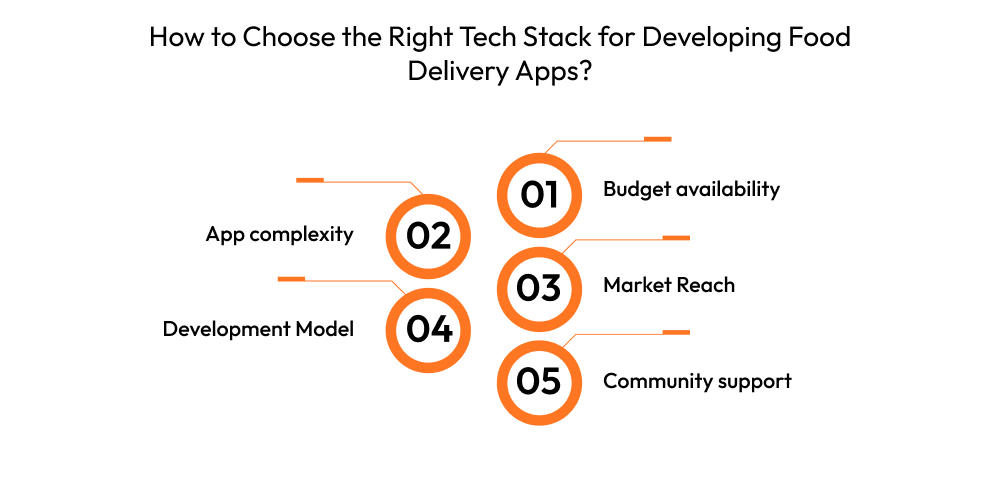
1. Budget availability
Whether you can choose native development or want a cross-platform, cost-effective solution depends on your budget. Higher development costs or licensing fees may apply to certain tools and frameworks. Give top priority to solutions that strike a balance between cost and quality.
2. App complexity
The tech stack should be more strong the more complicated your app is, including real-time tracking, dynamic pricing, and many connectors. Select frameworks and languages that can manage these features by approaching a food delivery app development company in UK.
3. Market Reach
A cross-platform framework like Flutter or React Native can be the best option if you want to reach both iOS and Android customers. Platform-specific benefits may be provided via native development for a more customized experience.
4. Development Model
The tech stack you select is impacted by your strategy, whether it is in-house, outsourced, or hybrid. While outsourced partners might contribute knowledge of more recent, affordable technologies and a food delivery app monetization model may favor well-known stacks.
5. Community support
Choosing a tech stack with robust community support guarantees third-party integrations, upgrades, and troubleshooting assistance. Future-proof and well-documented tools are more likely to have vibrant developer communities. This lowers long-term technical debt and expedites progress.
Major Use Cases to Study
Food delivery apps change depending on the objectives of businesses and are made easier by various use cases. For success, startups need a tech stack for food delivery app development:

1. For a Startup/MVP
A startup that wants to release an MVP can concentrate on essential functions like menu browsing, user registration, and simple order processing. Time and money can be saved with the use of technologies like Firebase and Flutter. The objective is to collect user input with food delivery app tech stack.
2. For a Scalable Enterprise App
With features like real-time tracking, CRM connection, and AI-based personalization, a large enterprise software requires a strong, safe, and high-performing architecture. Scalability and dependability are guaranteed by technologies like AWS, Kubernetes, and Node.js.
Future Technologies for Building Food Delivery Applications
Adopting a tech stack for food delivery app development that improves automation and user experience is crucial. The way that consumers order, track, and get food will be completely changed:
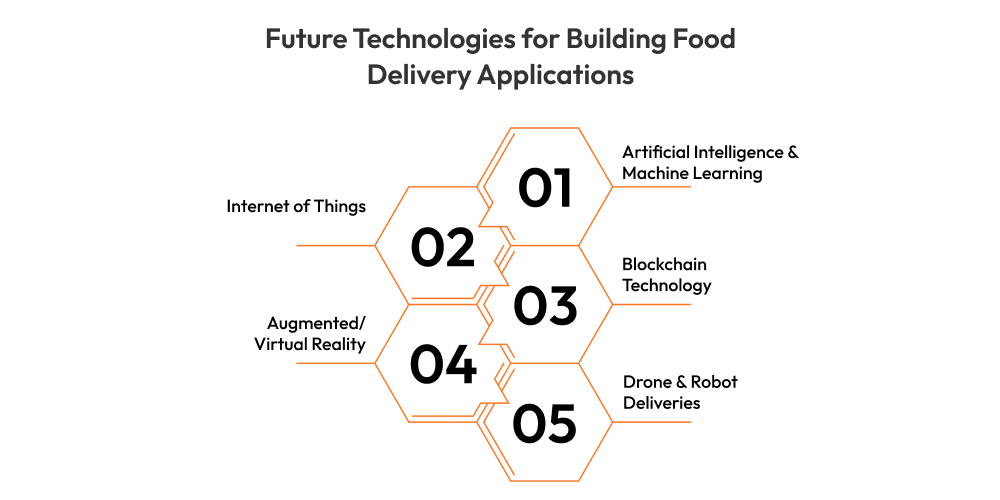
1. Artificial Intelligence & Machine Learning
AI/ML facilitates meal recommendations, delivery route optimization, and user experience personalization. The technology used to build a food delivery app also helps with demand forecasts. Customer satisfaction, efficiency, and app intelligence are all enhanced by these technologies.
2. Internet of Things
IoT makes it possible to track the location and temperature of food items in real time while they are in transit. The software can also connect to delivery equipment and smart kitchen appliances to automate tasks. This influences the food delivery app development cost in Europe at a larger scale.
3. Blockchain Technology
Blockchain can be used to track food supply chains, validate orders, and improve payment security. It fosters openness and confidence among customers, delivery partners, and eateries. Order validation and payment settlements can be automated with smart contracts.
4. Augmented/Virtual Reality
Before placing an order, users can experience dynamic 3D meal previews thanks to AR. VR can be utilized to immerse users in brand encounters or to explore virtual restaurant surroundings. A grocery app development company uses these technologies to improve customer engagement.
5. Drone & Robot Deliveries
Delivery times and operating expenses can be greatly decreased with the use of drones and self-governing robots. They guarantee prompt, contactless delivery, particularly in places with high demand or metropolitan areas. This forward-thinking strategy improves consumer happiness and last-mile logistics.
Final Thought!!
The basis for a dependable, scalable, and entertaining platform is laid by choosing the appropriate tech stack for food delivery app development. Businesses may guarantee quicker development, improved performance, and strong security by combining frontend frameworks, backend technologies, databases, and cloud infrastructure.
Future expansion and real-time operations should all be supported by the mobile app tech stack for food delivery. For logistics and delivery management in food delivery apps, development teams may create competitive apps that meet changing market expectations and provide long-term value by matching tools with project objectives and user needs.
FAQs
Q1. What is a Tech Stack in Food Delivery App Development?
The tools, frameworks, and programming languages used to create a meal delivery app are referred to as a tech stack. Front-end, back-end, database, APIs, and hosting infrastructure are all included. Performance, scalability, and quicker development cycles are guaranteed when the proper stack is selected.
Q2. Which Programming Languages are Best for Food Delivery Apps?
While Swift (iOS) and Kotlin (Android) work well for native apps, JavaScript (React Native) is best suited for cross-platform applications. For backend services, Ruby, Node.js, and Python are widely used. The decision is based on the budget, preferred platform, and complexity of the project.
Q3. What are the Essential Backend Technologies?
Ruby on Rails, Django (Python), and Node.js are frequently used for developing APIs and backend functionality. They oversee server-side logic, order processing, data, and authentication. Data flow, performance, and security are guaranteed via a strong backend.
Q4. Which APIs Should be Integrated into a Food Delivery App?
Firebase, Twilio, Stripe or Razorpay, and Google Maps are all essential APIs. For restaurant data, you can also utilize Yelp, Zomato, or comparable APIs. These improve user experience and app functionality.
Q5. Is a Cross-Platform Framework Better Than Native Development?
Flutter and React Native are examples of cross-platform frameworks that cut down on development time and expense. For both the iOS and Android platforms, they permit a single codebase. On the other hand, native apps offer superior hardware integration and performance.
Q6. How do I Choose the Right Tech Stack for my Food Delivery App?
Examine your project’s budget, scalability requirements, and requirements first. Think about long-term maintenance, community support, and developer availability. The most effective tech stack can be finalized with the assistance of seasoned experts.
